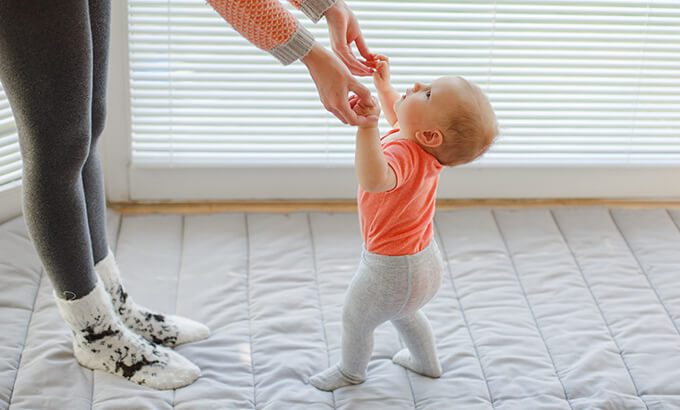Ways to Teach a Baby to Walk
Stages of Walking
From 4 -15 months, your baby learns to sit and walk around the house. During this exciting time, you can help your baby build self-confidence on their first steps with simple games and words of praise.
Stage 1: Sitting
The baby is in the initial stage of gaining mobility when it starts to sit up on its own without the help of a parent. Sitting helps your little ones strengthen the muscles they will need when they finally learn to stand.
Age : 4-7 months
What can you do? During playtime, move it back and forth or play with small balls to help him develop his small muscles.
Stage 2: Crawling
The most important thing a baby needs to do during the walking phase is to move his arms and legs at the same time (even if he’s crawling or climbing on his tummy). He’ll need these skills when he gets to the walking stage.
Age: 7-10 months
What can you do? Help him learn and improve these areas by going from one side of the room to the other and praise him for his action.
Stage 3: Correcting Your Posture
As the baby gets stronger and more curious, he starts to pull the furniture to himself with the support of his parents. This allows him to start working on his balance and recognize the standing position.
Age: 8 months
What can you do? Help baby pull himself up, then show him how to bend his knees to return to the floor. This will help make it easier for them to fall when they start to take their own steps.
Stage 4: Assisted Walking
Help her take a few steps as she begins to pull herself up and regain her balance. This will help him through the next walking phase and help him feel confident to take the first steps.
Age: 8-9 months
What can you do? Practice, practice. At this stage, the baby is in the most important walking period. The more he uses standing and standing, the more comfortable he will feel about taking the first few steps.
Stage 5: Cruising
Your baby will then begin to use walls and furniture to move around. This is called a cruise. Once baby becomes more mobile, make sure your home is completely baby-proof and secure all furniture to the wall.
Age: 8-9 months
What can you do? Encourage baby to be more safe while navigating, and don’t let him touch walls or furniture. Just make sure you have a soft landing spot.
Stage 6: Standing Without Aid
Balance is an important part of walking. If the Baby can stand and balance, he soon feels that he can try to take a step.
Age: 9-12 months
What can you do? Turn the balancer into a game. Sit on the floor with your baby and help him stand up. Then count how long you can stay before you fall. Praise him after each attempt.
Stage 7: First Steps
The first steps are one of the most important moments of your little ones. Walking is all about confidence, so everything down to those first steps takes praise and encouragement.
Age: 9-12 months
What can you do? Take the first steps by placing your baby on the ground and guiding him slowly, allowing the baby to walk on his own, gaining balance.
Stage 8: Walking
It may experience a few stumbling blocks and stumbling blocks before taking action. Keep praising your baby as he begins to explore walking. Keep in mind that some babies will prefer to crawl and can crawl-walk without getting up regularly.
Age: 12-15 months
What can you do? Encourage walking as much as possible. For example, when you put the baby down, position him for walking rather than sitting.
